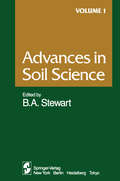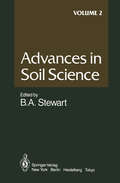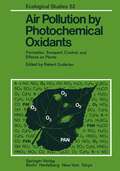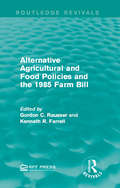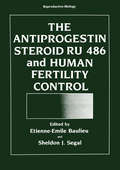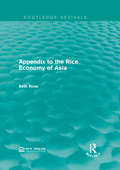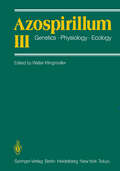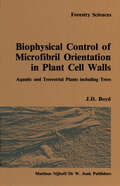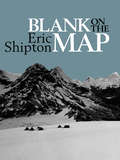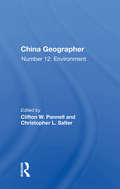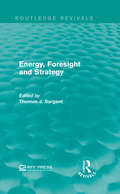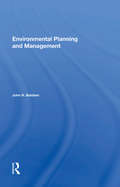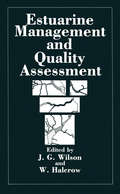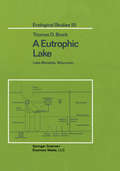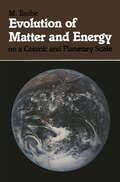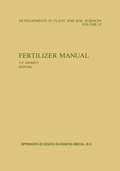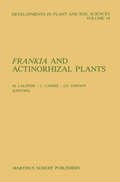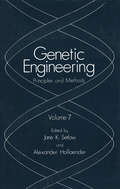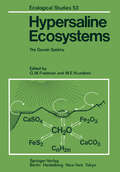- Table View
- List View
The Well-Chosen Garden
by Christopher LloydThe perfect book on how to make your garden the best it can be.'Essential reading' Country Life'Funny, encouraging, informative' Sunday TimesWould your garden, small or large, in town or country, win a prize? Is there room for improvement? Everybody has favourite plants, but the ability to put them all together to ensure a splendid show throughout the year is a skill that must be acquired. THE WELL-CHOSEN GARDEN will guide you to making the most of your available space, help you avoid untimely gaps, colour clashes and many other pitfalls of garden planning.The perfect book for new and experienced gardeners alike.
Advances in Soil Science (Advances in Soil Science #1)
by F. T. Bingham J. T. Cope H. V. Eck S.A. El-Swaify C. E. Evans L. B. Fenn L. R. Hossner R. Keren J. Letey P. Pathak T. J. Rego U. Schwertmann I. Shainberg S. Singh P. W. UngerThe world population in 1930 was 2 billion. It reached 3 billion in 1960, stands at 4. 6 billion today, and is expected to reach 6 billion by the end of the century. The food and fiber needs of such a rapidly increasing population are enormous. One of the most basic resources, perhaps the most basic of all, for meeting these needs is the soil. There is an urgent need to improve and protect this resource on which the future of mankind directly depends. We must not only learn how to use the soil to furnish our immediate needs, but also ensure that the ability of the soil to sustain food production in the future is unimpaired. This is indeed a mammoth task; a 1977 United Nations survey reported that almost one-fifth of the world's cropland is now being steadily degraded. This volume is the first of a new series entitled Advances in Soil Science. The diversity of soil makes it necessary for research to be conducted in many locations. There are basic principles, however, that are universal. This new series will present clear and concise reviews in all areas of soil science for everyone interested in this basic resource and man's influence on it. The purpose of the series is to provide a forum for leading scientists to analyze and summarize the available scientific information on a subject, assessing its importance and identifYing additional research needs.
Advances in Soil Science: Volume 2 (Advances in Soil Science #2)
by E. Bragg J. M. Lynch K. Mengel C. W. Rose K. WadaThe world population in 1930 was 2 billion. It reached 3 billion in 1960, stands at 4. 6 billion today, and is expected to reach 6 billion by the end of the century. The food and fiber needs of such a rapidly increasing population are enormous. One of the most basic resources, perhaps the most basic of all, for meeting these needs is the soil. There is an urgent need to improve and protect this resource on which the future of mankind directly depends. We must not only learn how to use the soil to furnish our immediate needs, but also ensure that the ability of the soil to sustain food production in the future is unimpaired. This is indeed a mammoth task; a 1977 United Nations survey reported that almost one-fifth of the world's is now being steadily degraded. The diversity of soil makes it cropland necessary for research to be conducted in many locations. There are basic principles, however, that are universal. This, Advances in Soil Sciences, presents clear and concise reviews in all areas of soil science for everyone interested in this basic resource and man's influence on it. The purpose of the series is to provide a forum for leading scientists to analyze and summarize the available scientific information on a subject, assessing its importance and identifying additional research needs. But most importantly, the contributors will develop principles that have practical applications to both developing and developed agricultures.
Air Pollution by Photochemical Oxidants: Formation, Transport, Control, and Effects on Plants (Ecological Studies #52)
by K. H. Becker W. Fricke R. Guderian J. L. Löbeö R. Rabe U. Schurath D. T. TingeyPhotochemical oxidants are secondary air pollutants formed under the influence of sunlight by complex photochemical reactions in air which contains nitrogen oxides and reactive hydrocarbons as precursors. The most adverse components formed by photochemical reactions in polluted air are ozone (0 ) 3 and peroxyacetyl nitrate (PAN), among many other products such as aldehydes, ketones, organic and inorganic acids, nitrates, sulfates etc. An analysis and evaluation of the available knowledge has been used to characterize the relationships among emissions, ambient air concentrations, and effects, and to identify the important controlling influences on the formation and effects of photochemical oxidants. The biological activity of photochemical oxidants was first clearly manifested during the early 1940's, when vegetation injury was observed in the Los Angeles Basin in the United States. Since that time, as a consequence of the increasing emissions of photochemical oxidant precursors, the photochemical oxidants have become the most important air pollutants in North America. In other parts of the world, for example South and Central America, Asia, and Australia, photo chemical oxidants threaten vegetation, particularly the economic and ecological performance of plant life. According to my knowledge, the first observations of ozone and PAN injury to vegetation in Europe were made by Dr. Ellis F. Darley (Statewide Air Pollution Research Center, University of California, Riverside, California) during a study visit (1963/64) to the Federal Republic of Germany.
Alternative Agricultural and Food Policies and the 1985 Farm Bill (Routledge Revivals)
by Gordon C. Rausser Kenneth R. FarrellIn 1985, the U.S. Congress confronted the difficult and complex task of developing a 5-year omnibus legislation allowing for lower commodity prices. But, policies predicated on the concept of agriculture as a unique sector of the economy became less and less appropriate to the highly interdependent, open agricultural economy throughout the 1980s. First published in 1985, this collection of 16 papers and related discussions contained in these proceedings is an important contribution toward understanding the issues, options, and dilemmas in U.S. agricultural policy. This is an ideal title for students interested in environmental studies, agriculture, and national policy.
Alternative Agricultural and Food Policies and the 1985 Farm Bill (Routledge Revivals)
by Gordon C. Rausser Kenneth R. FarrellIn 1985, the U.S. Congress confronted the difficult and complex task of developing a 5-year omnibus legislation allowing for lower commodity prices. But, policies predicated on the concept of agriculture as a unique sector of the economy became less and less appropriate to the highly interdependent, open agricultural economy throughout the 1980s. First published in 1985, this collection of 16 papers and related discussions contained in these proceedings is an important contribution toward understanding the issues, options, and dilemmas in U.S. agricultural policy. This is an ideal title for students interested in environmental studies, agriculture, and national policy.
The Antiprogestin Steroid RU 486 and Human Fertility Control (Reproductive Biology)
by Etienne-Emile BaulieuAdvances in basic biological research have proceeded rapidly in recent years. The fields of molecular genetics and immunology have experienced dramatic breakthroughs, capturing the imagination of both the scientific community and the general public. With less public notice, receptor biology has brought a cascade of new discoveries and insights. The entire science of pharmacology has been virtually rewritten in terms of receptor phenomenology. In particular, the discovery of specific receptors for steroid and protein hormones has been of seminal importance. With this new information, we have advanced our understanding of the mechanism and specifity of hormone action. We can now explain how hormones interact selectively with specific target cells and how hormones alter biochemical events within the target cells. These facts have already impacted on applied problems of clinical medicine, particularly in diagnosis and treatment of cancer and some metabolic diseases. Now, a new and important application of basic receptor biology and chemistry looms ahead. Within a few short years since the discovery of the progesterone receptor, chemists have synthesized molecules with a greater affinity for the receptor than progesterone itself and which, while occupying the receptor, fail to trigger the events which transform a target cell from the unstimulated to the stimulated state. This is the basis of the competitive inhibitory action of the anti-progestational agent, synthesized by the chemists at Roussel Uc1af, Paris, and designated RU 486.
Appendix to the Rice Economy of Asia (Routledge Revivals)
by Beth RoseOriginally published in 1985, Beth Rose’s Appendix to the Rice Economy of Asia provides twenty-six tables detailing various rice statistics across Asia from the beginning of the twentieth century through to the 1980’s. Statistics presented include; total crop area, rice production and yield, import and export, rice prices, farm wages and populations of countries or areas within Asia. This title will be of interest to students of Environmental Studies and Economics.
Appendix to the Rice Economy of Asia (Routledge Revivals)
by Beth RoseOriginally published in 1985, Beth Rose’s Appendix to the Rice Economy of Asia provides twenty-six tables detailing various rice statistics across Asia from the beginning of the twentieth century through to the 1980’s. Statistics presented include; total crop area, rice production and yield, import and export, rice prices, farm wages and populations of countries or areas within Asia. This title will be of interest to students of Environmental Studies and Economics.
Azospirillum III: Genetics · Physiology · Ecology Proceedings of the Third Bayreuth Azospirillum Workshop
by Walter KlingmüllerBiophysical control of microfibril orientation in plant cell walls: Aquatic and terrestrial plants including trees (Forestry Sciences #16)
by J.D. BoydWithin the extreme diversity of aquatic and terrestrial plant genera, each has characteristic cell wall forms. A number of hypotheses have been advanced to explain differences in microfibril arrangements across anyone such wall. Of those, only the 'multinet' theory, which involves the postulation of reorientation of microfibrils caused by cell extension, now has a substantial number of ad herents. However, many scientists are sceptical of its validity; obviously it is incompatible with various observed microfibril arrangements. The tenet of this study is that any such hypothesis can be valid only if it is applicable to all plant forms and wall types. Initially, reanalyses are made of data claimed to confirm justification for multi net postulations. The results show that previous deductions from those data, in support of multinet, are subject to serious challenge. Similarly, a re-examination of the observations, which inspired the multinet theory, shows they have a more logical explanation. Herein, it is concluded that cell wall development involves biophysical factors, which neces sarily prevent multinet's postulated large reorientations of microfibrils, after their formation. Unfortunately the previously most recent published theory, which is based on the absence of reorientation during extension, fails to answer the fundamental question of how alternating orientations between lamellae are controlled, or explain variations in thickness of wall layers. Extensive published data are used to identify forces involved in cell wall development.
Blank on the Map: Pioneering exploration in the Shaksgam valley and Karakoram mountains.
by Eric Shipton'As I studied the maps, one thing about them captured my imagination … Across this blank space was written one challenging word, "Unexplored"' In 1937 two of the twentieth century's greatest explorers set off to explore an unknown area of the Himalaya, the breath-taking Shaksgam mountains. With a team of surveyors and Sherpas, Eric Shipton and H.W. Tilman located and mapped the land around K2, the second-highest mountain in the world. It was their greatest venture, and one that paved the way for all future mountaineering in that area of the Himalaya. For Shipton and Tilman, exploration was everything, with a summit a welcome bonus, and Blank on the Map is the book that best captures their spirit of adventure. With an observant eye and keen sense of humour, Shipton tells how the expedition entered the unknown Shaksgam mountains, crossing impenetrable gorges, huge rivers and endless snow fields. There's a very human element to in Shipton's dealings with his Sherpa friends, and with his Balti porters, some of whom were helpful, while some were less so. The expedition uncovers traces of ancient cultures and visits vibrant modern civilisations living during the last days of the British Empire. Only when all supplies are exhausted, their clothes in tatters and all equipment lost do the men finally return home. A mountain exploration classic.
China Geographer: No. 12: The Environment
by Clifton W. Pannell Christopher L. SalterThis book seeks to promote better understanding of China through improved knowledge of its geography. It presents papers on a variety of environmental topics in China ranging from earthquake hazards to nature preserves. New research techniques and analytical methodologies are also presented.
China Geographer: No. 12: The Environment
by Clifton W. PannellThis book seeks to promote better understanding of China through improved knowledge of its geography. It presents papers on a variety of environmental topics in China ranging from earthquake hazards to nature preserves. New research techniques and analytical methodologies are also presented.
Energy, Foresight and Strategy (Routledge Revivals)
by S. Rao Aiyagari Zvi Eckstein Martin S. Eichenbaum Dennis Epple Lars Peter Hansen Raymond G. Riezman William RoberdsThe essays in Energy, Foresight and Strategy apply rational expectation theory to various energy markets with the intention of discussing issues relevant to analysis and decision making in the whole of the energy field. Originally published in 1985, issues explored include oil exportation, energy prices and embargoes, both focussing on how past regulation has created issues in the market at the time of publication as well as creating models to ascertain the futures of various energy resources. This title will be of interest to students of Environmental Studies and Economics.
Energy, Foresight and Strategy (Routledge Revivals)
by Thomas J. SargentThe essays in Energy, Foresight and Strategy apply rational expectation theory to various energy markets with the intention of discussing issues relevant to analysis and decision making in the whole of the energy field. Originally published in 1985, issues explored include oil exportation, energy prices and embargoes, both focussing on how past regulation has created issues in the market at the time of publication as well as creating models to ascertain the futures of various energy resources. This title will be of interest to students of Environmental Studies and Economics.
Environmental Planning And Management
by John H BaldwinA comprehensive overview and discussion of all major aspects of environmental planning and management, Professor Baldwin's textbook highlights the causes and interrelationships of environmental problems, emphasizing the important economic and ecological functions of the land as the stage for all human activities and the "source" and "sink" for all
Environmental Planning And Management
by John H BaldwinA comprehensive overview and discussion of all major aspects of environmental planning and management, Professor Baldwin's textbook highlights the causes and interrelationships of environmental problems, emphasizing the important economic and ecological functions of the land as the stage for all human activities and the "source" and "sink" for all
Estuarine Management and Quality Assessment
by J. WilsonThis volume presents the papers given at the meeting "Estuarine Management and Quality Assessment" held at Trinity College, Dublin in September 1983. The meeting was organised by the Environmental Sci ences Unit, TCD and the Estuarine and Brackish-Water Sciences Associ ation and was attended by delegates from the United Kingdom, Ireland, France, Holland and Portugal. The theme for the meeting was deliberately chosen in an attempt to bring together the various disciplines and interests in the field of estuarine quality, and the extent to which this objective was met may be judged from the diversity of the contributions. The meeting was arranged under three sub-headings which could be roughly summar ised thu- a) Modelling - as representative of the engineering hydrodynamicist approach. b) Impact - as representative of the biologist-type approach. c) Management - attempting to reconcile the different approaches to, and demands on, the estuary. In fact, since most contributions overlapped into the other two categories, the order in this volume has been changed somewhat from the meeting, and we feel that this book may be fairly presented as one unit. Contributions for which it was not possible to give full transcripts have been included, for completeness, as abstracts. In each session, an invited speaker summarised the state of the art, and the other speakers followed up by describing some new approach to or refinement of the problem.
A Eutrophic Lake: Lake Mendota, Wisconsin (Ecological Studies #55)
by Thomas D. BrockLake Mendota has often been called "the most studied lake in the world. " Beginning in the "classic" period of limnology in the late 19th century and continuing through the present time, this lake has been the subject of a wide variety of studies. Although many of these studies have been published in accessible journals, a significant number have appeared in local monographs and reports, ephemeral documents, or poorly distributed journals. To date, there has been no attempt at a synthetic treatment ofthe vast amount of work that has been published. One intent of the present book is to present a com prehensive compilation of the major early studies on Lake Mendota and to examine how they impinge on important present-day biological questions. In addition, this book presents a summary of field and laboratory work carried out in my own laboratory over a period of about 6 years and shows where correlations with earlier work exist. The book should be ofinterest to limnologists desiring a ready reference to data and published papers on this important lake, to biogeochemists, ocean ographers, and low-temperature geochemists interested in lakes as model sys tems for global processes, and to lake managers interested in understanding short-term and long-term changes in lake systems. Although the major thrust ofthe present book is ecologicaland environmental, sufficient background has been presented on other aspects ofLake Mendota's limnology so that the book should also be useful to nonbiologists.
Evolution of Matter and Energy on a Cosmic and Planetary Scale
by M. TaubeMy intention in this book is to describe in simple language, using a minimum of mathematics but a maximum of numerical values, the most important developments of science dealing with matter and energy on cosmic and global scales. In the conventional literature all of these findings are distributed among books and journals on physics, astronomy, chemistry, geology, biology, energy, engineering, and the environmental sciences. The main purpose here is to attempt to give a unified description of Nature from the elementary particles to the Universe as a whole. This is used as a basis for analysing the future development of mankind. The future evolution of the Universe, galaxies, stars, and planets gives some hope for the destiny of mankind. The problem of matter and energy flow on the Earth appears soluble even for the distant future. There seems to be no reason why a long period of human development on this planet should not be possible. The book has been prepared based on my lectures at the Warsaw University from 1959 to 1968 and during the 15 years 1969-1983 at the Swiss Federal Institute of Technology (Eidgenossische Technische Hochschule) in Zurich and at the University of Zurich. I wish to give my sincere thanks to the Swiss Federal Institute for Reactor Research at Wurenlingen for their constant support. I am especially grateful to Mrs. Christine Stratton for setting up the English text and to Mr. R.W. Stratton and LG. McKinley for their helpful criticisms and remarks.
Fertilizer Manual (Developments in Plant and Soil Sciences #15)
by Travis P. HignettThis Fertilizer Manual was prepared by the International Fertilizer Development Center (IFDC) as a joint project with the United Nations Industrial Development Organi zation (UNIDO). It is designed to replace the UN Fertilizer Manual published in 1967 and intended to be a reference source on fertilizer production technology and economics and fertilizer industry planning for developing countries. The aim of the new manual is to describe in clear, simple language all major fertilizer processes, their requirements, advan tages and disadvantages and to show illustrative examples of economic evaluations. The manual is organized in five parts. Part I deals with the history of fertilizers, world outlook, the role of fertilizers in agriculture, and raw materials and includes a glossary of fertilizer-related terms. Part II covers the production and transportation of ammonia and all important nitrogen fertilizers-liquids and solids. Part III deals with the characteristics of phosphate rock, production of sulfuric and phosphoric acid, and all important phosphate fertilizers, including nitrophosphates and ammonium phosphates. Part IV deals with potash fertilizers-ore mining and refining and chemical manufac ture; compound fertilizers; secondary and micronutrients; controlled-release fertilizers; and physical properties of fertilizers. Part V includes chapters on planning a fertilizer industry, pollution control, the economics of production of major fertilizer products anJ intermediates, and problems facing the world fertilizer industry.
Frankia and Actinorhizal Plants (Developments in Plant and Soil Sciences #18)
by M. Lalonde C. Camiré J. O. DawsonThe fifth meeting of scientists working with Frankia and actinorhizal plants was held at Montmorency Forest of Laval University in Quebec from August 6-8, 1984. Results of research presented at the meeting are included in this special volume of Plant and Soil. The understanding of actinorhizal systems continue to increase, though work and use shops and discussions at this and similar meetings make it evident that this important subject remains open for fruitful investigation at all levels. Some important 'firsts' were reported at this meeting. The first extensive survey of Frankiae and their host specificity ranges from Asia was presented. This is of significance since Asia is a center of diversity for many actinorhizal host plant genera. A report that proto plasts of Frankia have been produced and regenerated for the first time improves the possibility for genetic manipulation of Frankia. It is also important to note the first report herein of successful mass inoculation of actinorhizal plants commercially for stabilization and reclamation of disturbed soils around hydroelectric power projects in Quebec. This heralds the transfer of actinorhizal technology to private and public users. The bacterial genus Frankia is easily recognized both in vivo and in vitro, and isolation of this organism has become routine. But, as yet, there are not sufficient biochemical, morphological, or anatomical criteria for establishing species.

